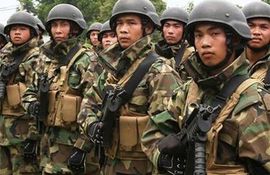INTRODUCTION[hr]http://nswiki.org/images/thumb/APIFPU.png/188px-APIFPU.png
Illustration I: Official Flag
http://nswiki.org/images/thumb/APIS.png/128px-APIS.png
Illustration II: Official Coat of Arms
MottoPara sa aking mga tao, para sa aking dagat (For my people, for my sea)AnthemAsul na dagat (Blue Sea)CapitalLinamaLargest cityVadooOfficial languageIslanderDemonymIslanderGovernmentParliamentary democracy under a constitutional monarchy (personal union)Area45,000km² (17,375miles²)Population2,000,000 (44/km² or 114/mile²)GDP26 billion kiribs (13,000 kiribs per capita)CurrencyAng (Ā)
The Grand Constitutional Monarchy of the Asian Pacific Islands is a tropical island nation in The East Pacific region, on the planet Urth in the Pacific Ocean . It lies to the south west of The Oan Isles . It is an island nation with a tropical climate characterised by a mountainous topography and tropical rainforests. The country has many endemic plants and animals. It has beautiful, warm clear seas. It has a high rate of precipitation. The country forms part of the larger Polynesian geographic subregion. It is affected by ash clouds and Urthquakes due to its close proximity to active geological faults.
The country forms part of the Polynesian Union, by which it shares a monarch with the Oan Isles, however it is a fully sovereign nation with its own institutions. It is a democratic nation with power vested in a democratically elected National Assembly which elects the executive branch. The head of government and leader of a multi-party democracy is the Prime Minister who leads the largest party. The nation has close ties with the Oan Isles as a major ally. The nation’s defence is facilitated primarily by the Islander Defence Force, a relatively small force that primarily handles emergency response and territorial defence.
The country is a developing, upper middle income economy, and has an economy of 26 billion kiribs and a GDP per capita of 13,000 kiribs. The primary export earnings are from consumer goods, fish, wood, textiles, pharmaceuticals and agricultural products. The primary imports are manufactured goods and fossil fuels. Many people live in poverty, unemployment is reasonable. Through geothermal power, the nation has reliable access to electricity and has a reasonably developed infrastructure, although the rural areas have issues. The nation is diverse, formed of many subethnic and subcultural groups that broadly form the Islander linguistic and cultural community (the last remaining language group of the East Polynesian language family). The nation is devout with a syncretism of Buddhism and folk spiritual beliefs forming the majority religion.

